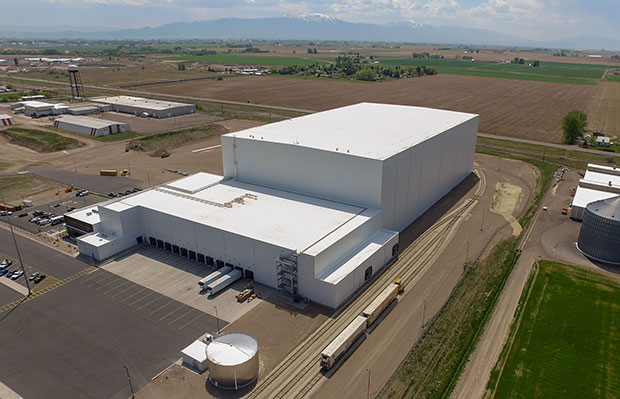Dutch logistics service provider NewCold has constructed one of North America’s largest freezer warehouses in Burley, Idaho. The new facility is highly automated, allowing for a high capacity with low energy consumption.
 For many professional and amateur chefs, fries and McCain are inseparable. Anyone in the northwestern US who has bought frozen potato products from the family business has most likely held a package that had previously been stored in the XXL freezer in Burley. The distribution center that opened in the small city in late 2019 is already known across the industry: the 138-foot-tall high bay warehouse makes an impression with its size and state-of-the art automation.
For many professional and amateur chefs, fries and McCain are inseparable. Anyone in the northwestern US who has bought frozen potato products from the family business has most likely held a package that had previously been stored in the XXL freezer in Burley. The distribution center that opened in the small city in late 2019 is already known across the industry: the 138-foot-tall high bay warehouse makes an impression with its size and state-of-the art automation.
The fulfillment center, which handles a yearly throughput of roughly 700,000 pallets, was constructed in cooperation with TGW. The operator is the Dutch service provider NewCold, who manages a network of freezer warehouses in the US, Australia and Europe. The Burley freezer warehouse’s main customer is McCain Foods.
TGW’s freezer expertise
During the selection process, TGW had a clear advantage: NewCold was already familiar with TGW’s portfolio and its freezer expertise from previous joint projects. “Automation is one of the keys to meeting our customers’ needs. They are in the process of reorganizing their supply chains to achieve the greatest efficiency and the lowest costs possible,” explains Peter Verharen, Vice President Project Management at NewCold. “Automation is the only way to achieve the throughput that the market demands.”
According to the service provider, automated freezer warehouses offer many other advantages: the space required can be reduced by up to 60 percent compared to manual warehouses – an important argument in areas where land is scarce and/or costly. Other deciding factors are the shortage of skilled labor and the reduction of operating costs. According to NewCold, personnel costs in an automated warehouse can be up to 65 percent lower than in a manual distribution center, while energy consumption can be reduced by around 50 percent.
NewCold’s experience coincides with what Michael Schedlbauer, Industry Manager for grocery retail at TGW, has gleaned from numerous projects: “Alongside sustainability and increasing customer requirements, the shortage of skilled labor is the most significant reason that companies are automating their temperature-controlled warehouses. Such a step is even more worthwhile in freezer logistics than in other areas.” Finding, training, and retaining employees is the top priority on NewCold’s agenda. “Our employees are just as important to us as customer care and long-term profitability,” says Verharen. To that end, the logistics service provider concentrates on two success factors: good salaries and training. The company trains its employees using innovative software and technology.
Energy savings of up to two thirds
Alongside clever strategies, modern technologies are the key to significant energy conservation. “With an automated rather than a manual freezer warehouse, you can not only double productivity but also save up to two thirds of the cooling energy,” notes Schedlbauer.
High storage density is a central guiding principle when it comes to new construction projects. Compared to manual systems, the total area needed for an automated system is substantially smaller. NewCold only requires an area of 155,000 square feet for 90,000 pallet storage locations because the goods are distributed to the 14 levels by storage and retrieval machines. The maximum throughput rate is 189 pallets per hour (simultaneous storage and retrieval). The high bay warehouse is kept at a permanent -25 degrees Celsius, while the temperature in the picking area lies between -5 and -2 degrees Celsius.
Storage and retrieval is based on a dark warehouse concept, that allows for additional energy reduction. Intelligent material flow controls keep conveyor system movements and the opening of doors to a minimum. The installation in Burley presented TGW also with the challenge of pallet handling catered specifically for the US market. Trucks deliver goods not only on system pallets, but also on so-called “slip sheets” made of thin kraftliner. In the goods receiving area, forklifts transfer all deliveries to system pallets, where they are weighed and contour-checked. Afterwards, the load carriers are stored. A pallet exchange device handles the order-specific retrieval of goods, whether they be needed on system pallets, customer pallets, or slip sheets.




Comments are closed.